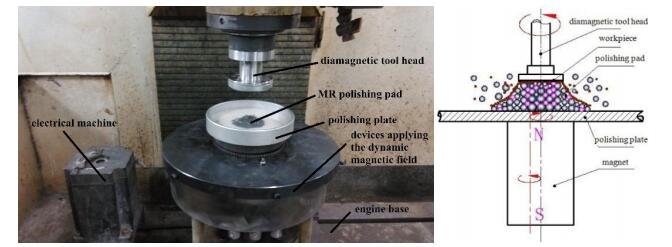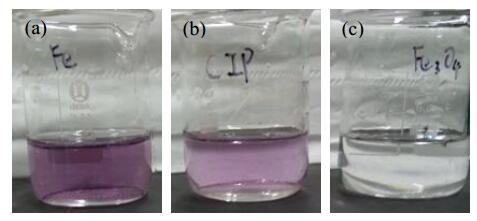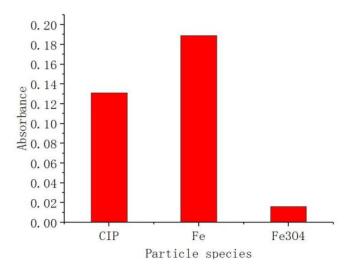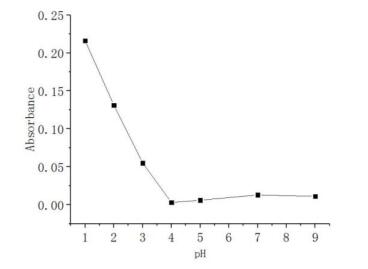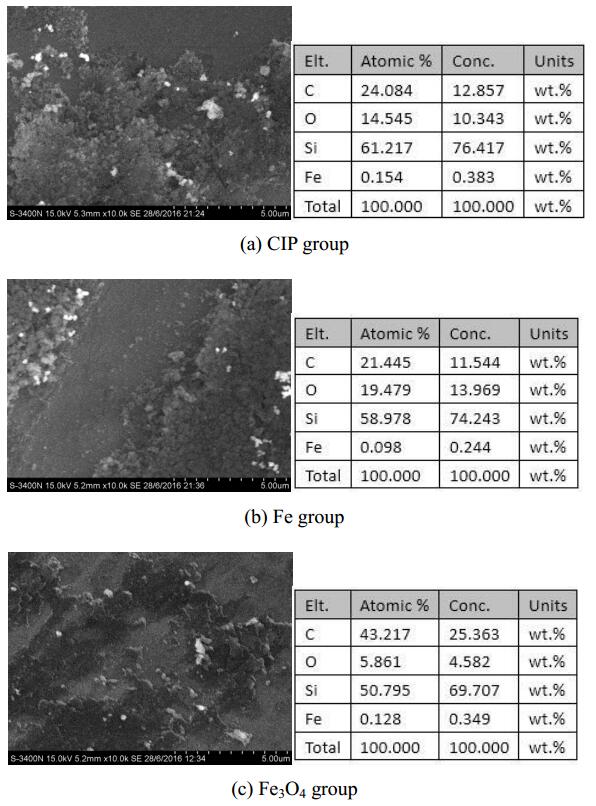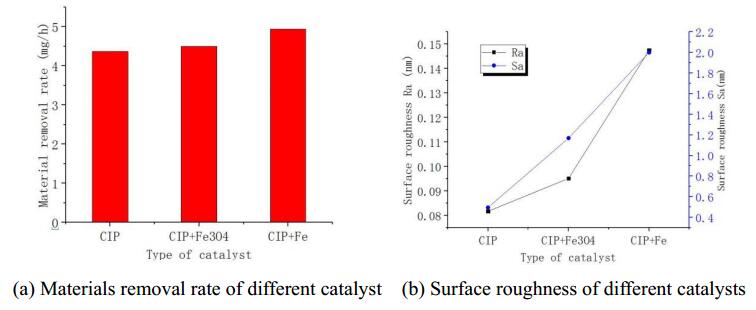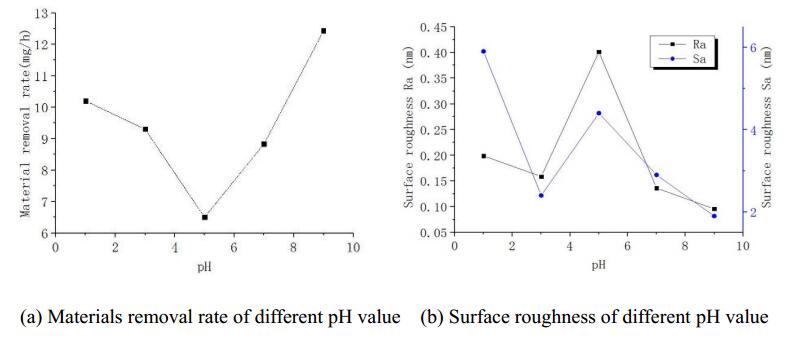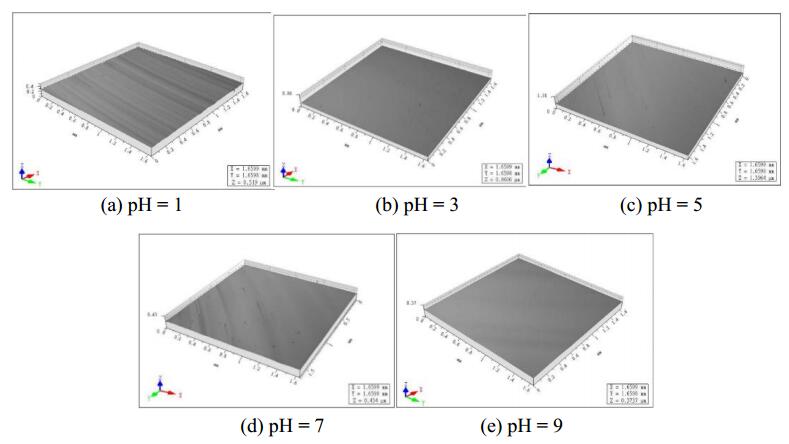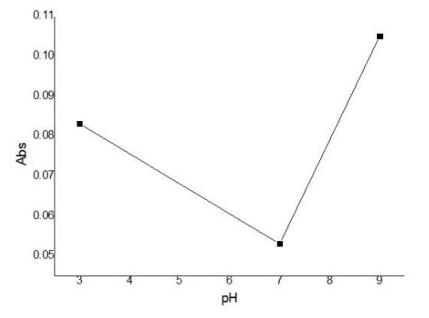1. Introduction
As the third generation semiconductor material, single crystal SiC has the characteristics of wide band gap, high breakdown electric field, thermal conductivity, strong radiation resistance and good chemical stability. It is suitable for making electronic devices which has the characteristics of high temperature, high frequency, radiation resistant, high-power and high-density integrated [1,2]. The application of single crystal SiC to epitaxial films requires smooth surface, no defect and no damage. However, due to the high hardness (Mohr hardness 9.2), high hardness and brittleness, and good chemical stability, high efficiency and ultra-precision flattening processing is very difficult [3].
Chemical mechanical polishing (CMP) is considered to be the most successful method of global planarization for semiconductor wafers at present [4]. Because of the anisotropy of SiC, it requires polishing by different acid or alkali polishing liquid. Aida et al. [5] used acidic and alkaline to polish Si-face and C-face of SiC through CMP respectively. It found that alkaline polishing slurry is effective for machining Si-face of SiC wafer with a material removal rate of 0.064 μm/h while acidic polishing slurry is better for polishing C-face with a material removal rate of 0.14 μm/h. Chen et al. [6] had polished 6H-SiC single crystal by alkaline polishing liquid which is containing colloidal SiO2 abrasive. The material removal rate of Si-face was 0.153 m/h, but the removal rate of C surface was only 0.006 μm/h. This shows that a good surface roughness of the SiC crystal can be obtained by CMP polishing, but the removal efficiency is very low. In order to improve the chemical oxidation of SiC materials, Fenton reaction is applied to polishing of SiC [7,8], which is a reaction system with strong oxidising property between H2O2 and Fe2+ to form hydroxyl radical (•OH) [9]. However, it is failed to effectively solve the processing efficiency of the problem.
For this reason, our research group proposed a chemical-magnetorheological compound finishing (CMRF) technique involving the flexibility and controllability of magnetorheological finishing (MRF). By applying the CMRF, single crystal SiC wafers can be processed using the polishing slurry where ferromagnetic particles are used as catalyst and H2O2 is taken as oxidant. After polishing for 60 min, the surface roughness of single-crystal SiC wafer decreases from Ra 50.86 to Ra 0.48 nm [10,11,12]. It shows the efficiency improve greatly.
Our previous work analyzed the effect of polishing fluids with different compositions, and focused on the effect of the components in polishing fluids on material removal. The results showed that CMRF can process SiC materials efficiently. However, the mechanism of Fenton reaction in the material removal process is not clear, especially the oxidation mechanism of catalyst on SiC has not been analyzed. Therefore, aiming at the intermediate process of material removal (chemical reaction), we systematically study the mechanism of catalysts on hydroxyl radical formation. On basis, corrosion and polishing experiments on SiC were conducted to explore the chemical reaction rates and effect of different catalyst.
2. Experimental method
2.1. Fenton reaction principle
CMRF of SiC is based on the Fenton reaction principle. The reaction principle is given by Eqs 1–4. Fenton reaction occurs between Fe2+ and H2O2 to produce •OH with strong oxidability, and Fe3+ is also produced, as shown in Eq 1. Next, •OH reacts with the SiC surface to produce soft, easily removed SiO2 (see Eq 2) while Fe3+ can be converted into Fe2+ and H+ (see Eq 3). During the aforementioned chemical reactions, Fe2+ cannot disappear during polishing but just plays a catalytic action. Fe2+ can be directly added to the polishing solution in liquid form, but H2O2 will be completely consumed in a very short time. In order to match the actual processing efficiency, Fe2+ can be derived from the ionization of solid particles, as shown in Eq 4. In this paper, as magnetic particles, carbonyl iron powders (CIPs) are used to form magnetorheological polishing pads in magnetic fields and as catalysts in chemical reaction.
|
Fe2++H2O2→Fe3++OH−+⋅OH
|
(1)
|
|
SiC+4⋅OH+O2→SiO2+2H2O+CO2↑
|
(2)
|
|
Fe3++H2O2→Fe2++⋅OOH+H+
|
(3)
|
The oxidation potential of hydroxyl radicals is very high. From Eqs 1–3, it can be found that key role in the chemical reaction of SiC surface is the hydroxyl radical (•OH), and the higher the concentration of •OH, the rate of chemical reaction on the surface of SiC faster. Surface material can be easier remove because SiC with high hardness is transformed into SiO2 oxide layer. Therefore, the concentration of •OH generated by the Fenton reaction will directly affect the removal efficiency and polishing effect of CMRF of the single crystal SiC.
2.2. Detection of •OH concentration
In order to characterize the catalytic ability of different particles in process of Fenton reaction, spectrophotometry is used to measure •OH concentration [13]. The detection is conducted on the basis of the reaction between 1.8 mol/L salicylic acid solution and •OH, which produces purple 2, 3-dihydroxy benzoic acid radicals and 2, 5-dihydroxy benzoic acid radicals (equation shown in Figure 1). The reaction product shows the largest absorption peak at a wave length of 510 nm, at which the concentration of the absorption can be detected by using a UV-2501PC ultraviolet-visible absorption spectrograph. The catalytic ability of different particles is judged on the basis of the absorption peak value.
A stable chemical reaction process is needed when using visible spectrophotometric method. When SiC reacts with hydroxyl radical, the chemical reaction of Eqs 1–3 occurs synchronously and persistently. If the solution in chemical reaction process is detected at this time, the result will be great random. Therefore, in the experiment for detecting the •OH concentration, the Fenton's reagents of corresponding concentration are mixed, that is, only those Fenton reactions in Eqs 1 and 3 occur.
2.3. Chemical reaction on SiC surface
The efficiency and effect of CMRF process are directly affected by the chemical reaction between SiC surface and hydroxyl radical. In order to study the chemical reaction rate of different solid catalysts on the SiC surface in the Fenton reaction, corrosion test of C-face was carried out. The solid powder, such as carbonyl iron powder (CIP), Fe and Fe3O4, were selected as solid phase catalyst, and the mass fraction of 10% hydrogen peroxide was added to the Fenton reagent, and the mass fraction of the catalyst was 1%. SiC was immersed in the corrosion solution 1 hour. Scanning electron microscope (SEM) was used to observe the change of the surface morphology of SiC wafers, and elemental analysis of corrosion products was carried out by X-ray energy dispersive spectrometer (EDS). The ability of different corrosion liquids to oxidize SiC wafer was judged according to the change of surface morphology and surface elements.
2.4. Polishing experiment
The polishing experiment was conducted using a self-developed MR polishing device (Figure 2). A magnetic substance was embedded into an eccentric wheel and a dynamic magnetic field was formed on the surface of the polishing plate as the eccentric wheel was rotated. Then, the MR slurry can form a dynamic flexible polishing pad under the effect of the dynamic magnetic field to mobilise the self-repairing capability of the abrasives and the polishing pad. The polishing experiment was carried out at rotation rates of 350 and 60 rpm for the workpiece and the magnetic pole, respectively, for 60 min with a polishing gap of 1.0 mm and a magnetic field strength of about 0.2 T. The C-face of SiC wafer to be polished had an original roughness of about Ra 40 nm was used as the experimental sample. Moreover, The CMRF liquid is composed of 5 wt% diamond with the average particle size of 1 μm, 20 wt% carbonyl iron powder with the average particle size of 2 μm and 5 wt% H2O2, and mixed with 1 wt% Fe and Fe3O4 (The particles size are about 2 μm), respectively. Then the CMRF liquid prepared by adjusting pH to 1~9. By using an electronic balance with a precision of 0.1 mg, the mass of the SiC before and after polishing was measured to calculate the material removal rate. The surface roughness and polished surfaces were measured by using Taylor Hobson's CCI HD non-contact optical 3D contourgraph. All materials used for experiments are shown in Table 1.
Table 1. Material parameters.
| Material |
purity |
source |
Material |
purity |
source |
| SiC |
99.99% |
TankeBlue Corporation, China |
Fe3O4 |
99.80% |
Aladdin Industrial Corporation, China |
| CIP |
99.50% |
Yuean Corporation, China |
H2O2 |
30% |
Yocom Corporation, China |
| Fe |
99.50% |
Aladdin Industrial Corporation, China |
salicylic acid |
99.50% |
Aladdin Industrial Corporation, China |
3. Experimental results
3.1. •OH concentrations
The results of three sets of Fenton reagent prepared by different particles are shown in Figures 3 and 4. Under the same H2O2 concentration, the effect of different catalysts on reaction varies greatly. Using salicylic acid as a capture agent for •OH, it is effective to produce •OH when the solution is purple. When Fe was used as the catalyst, the color of the solution was the deepest, and the absorbance value reached 0.189. The color of the CIP group was lighter and the absorbance value was 0.131, while the color of the solution was almost unchanged when Fe3O4 was used. These show that Fe particle is the most powerful catalyst. The main reasons for these differences are the difference in the ionization capacity of Fe particles and Fe oxides.
Considering that CMRF is based on CIPs to form polishing pad, and CIPs are also processed by wrapped Fe particles, and the catalytic ability is strong. Thus, CIP particles are selected to explore the influence of different pH conditions. The amount of Fe2+ determines the ability to generate hydroxyl radicals (Eq 1), while the acid base environment determines the amount of Fe2+ ionized by solid catalysts in the reaction system. The results of different pH value are shown in Figure 5. According to Figure 5, it shows that the content of hydroxyl radical is very high when pH = 1, reaching 0.216. The content of hydroxyl radical decreased with the increase of pH value. When the pH value increased to 4, the hydroxyl radical content was very low. It indicates that hydroxyl radicals are produced only when pH < 4, and it was difficult to generate hydroxyl radical in weak acid or alkaline environment. According to the related research results, the effect of Fenton reaction is better when the pH value is less than 3.
3.2. Reaction on SiC surface
The single crystal SiC was immersed in Fenton reagent prepared by different catalysts for 1 h, and the reaction surface of SiC was observed by scanning electron microscope and the results were shown in Figure 6. As shown in Figure 6, when CIP, Fe and Fe3O4 were used as catalysts respectively, there were obvious reaction layers on the surface of SiC. When the CIPs and Fe particles were used, the thickness of surface reaction layer was larger. However, when using Fe3O4 as catalyst, the reaction layer was thinner.
Further, the element analysis of the reaction layer was carried out by the energy dispersive spectrometer. In order to avoid misjudging the adhesion of catalyst particles as reaction layer, the content of Fe element was also detected besides detecting the element contents of Si, C and O. The proportion of carbon and silicon contents in SiC material should be 1:1. Because of the appearance of O element, the content of C and Si elements appeared different changes in varying degrees, and the order of the O element content is Fe group > CIP group > Fe3O4 group. In addition, Fe content of 3 samples are less than 0.2%, which shows that the O element can be not from adhesion of catalyst. According to Eq 3, the chemical reaction occurred on surface material of SiC to produce a soft SiO2 layer, and the catalytic capacity of the catalyst should be Fe > CIP > Fe3O4.
3.3. Polishing resluts
The material removal rate and surface roughness after processing are shown in Figure 7. The material removal rate was lower when carbonyl iron powder is simultaneously responsible for the formation of the polishing pad and catalyst. In order to improve the effect of chemical reaction, the removal rate of material was slightly increased after mixing Fe3O4 and Fe particles respectively (seen in Figure 7a). There was a similar result from the surface roughness. The surface roughness Ra and Sa were lower when only carbonyl iron powder exists. Both Ra and Sa increase after adding other catalysts. When adding Fe particles, surface roughness was the largest (seen in Figure 7b). This is mainly due to the fact that SiC surface materials are oxidized more uniformly when only one catalyst is used, and the surface reaction is partially inhomogeneous when mixed with other catalysts.
The carbonyl iron powder (CIP) was selected for polishing experiments at different pH conditions. The results were shown in Figure 8. The material removal rate was reduced and then increased in the range of pH value from 1 to 9. The material removal rate was the lowest when the pH value was 5. In terms of surface roughness, Ra and Sa were higher in the strong acid range, and then decreased, and the roughness increased to weak acid (pH = 5). However, the surface roughness decreases again in the alkaline range. Ra and Sa reached the lowest level at pH = 9, which were 0.0817 nm and 0.4955 nm respectively.
CMRF, based on Fenton reaction, integrates the advantages of magnetorheological finishing (MRF) and Chemical Mechanical Polishing (CMP) to form a chemical reaction layer on the workpiece surface at first through Fenton reaction. Next, the reaction layer is removed under the mechanical effect of MR polishing pad and abrasives, and the material removal model is shown in Figure 9. Moreover, carbonyl iron powder (CIP) in CMRF polishing slurry acts as catalyst to form a soft SiO2 reaction layer on the surface of SiC. At the same time, CIPs are transformed into a chain structure under the effect of an external magnetic field. The abrasives particles are held or constrained in these chains to contact the surface of the workpiece so as to achieve efficient removal of surface materials.
The main reason for the above polishing results is that there are two kinds of chemical reactions which produced hydroxyl radicals in polishing process. Figure 5 shows that the reaction generated hydroxyl radical only in the pH < 4, suggesting that Fenton reaction only works well at this time (Eq 1). The stronger the acidity, the more quantity of hydroxyl radicals, and the stronger chemical action. However, the strong acid environment also leads to instability of flexible polishing pad formed by CIPs. At pH = 1, the material removal rate is high but with higher surface roughness and the polished surface appeared large number of plastic removal traces, as shown in Figure 10a. When H+ content is reduced properly (at pH = 3), Fenton reaction still has good effect and the polishing pad is more stable, and the polishing effect is better as shown in Figure 10b. When pH value up to 5, there are few hydroxyl radicals in the Fenton reaction, indicating chemical effect is poor. The material removal rate is reduced greatly with surface roughness increasing. As the solution change to the alkaline environment, it found that material removal rate increased, and the roughness decreased. By detecting the content of hydroxyl radical in polished solution after processing (Figure 11), hydroxyl radical also has a high content atalkaline. It indicates that sufficient activation energy produced by processing friction is used to decompose hydrogen peroxide to generate hydroxyl radicals under alkaline environment (Eq 5). According to related study, the increase of temperature will promote the production of hydroxyl radical [14]. In addition, alkaline polishing liquid was used to produce hydroxyl radicals in CMP process [15]. The results show that the higher the content of OH− in alkalinity, the more hydroxyl radical, and the stronger the chemical action. The silica layer which was oxidized by hydroxyl radical also reacted with alkali to form silicate (Eq 6), which is easier to be removed. So the material removal rate is further increased and surface roughness decreases.
|
SiO2 + 2OH−→SiO2−3 + 2H2O
|
(6)
|
4. Conclusions
(1) The hydroxyl radicals produced by Fenton reaction can react with SiC surface to form SiO2 oxide with soft hardness, which can promote SiC chemical mechanical polishing effect.
(2) The surface roughness of SiC is better when only carbonyl iron powder is used, but the material removal rate is low, and mixing other catalysts can increase material removal rate.
(3) The acid environment can promote Fenton reaction and the polishing effect is better, while the oxidation layer of SiC surface is converted to silicate in the alkaline environmental.
Acknowledgments
This work was supported by the NSFC-Guangdong Joint Fund Project (Grant No. U180120098), the National Natural Science Foundation of China (Grant No. 51375097), and Science and Technology Project of Guangdong Province (Grant No. 2016A010102014).
Conflict of interest
All authors declare no conflict of interest in this paper.










 DownLoad:
DownLoad: 